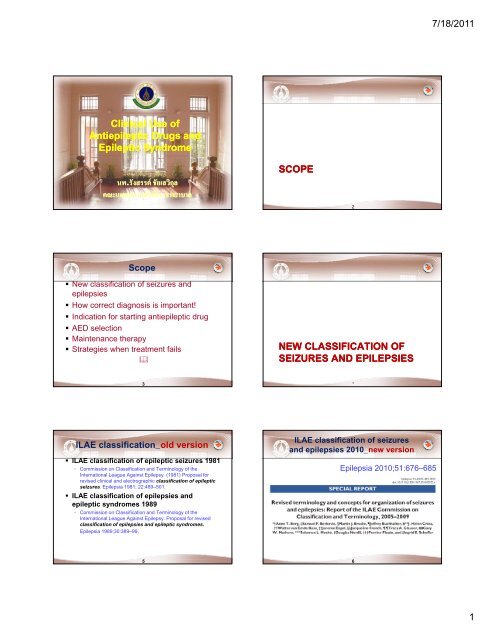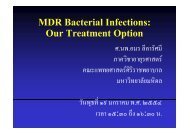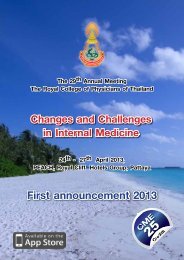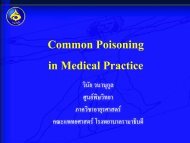7/18/2011 1 Clinical Use of Antiepileptic Drugs and Clinical Use of ...
7/18/2011 1 Clinical Use of Antiepileptic Drugs and Clinical Use of ...
7/18/2011 1 Clinical Use of Antiepileptic Drugs and Clinical Use of ...
You also want an ePaper? Increase the reach of your titles
YUMPU automatically turns print PDFs into web optimized ePapers that Google loves.
7/<strong>18</strong>/<strong>2011</strong><strong>Clinical</strong> <strong>Use</strong> <strong>of</strong><strong>Antiepileptic</strong> <strong>Drugs</strong> <strong>and</strong>Epileptic Syndromeนพ.รังสรรค์ ชัยเสวิกุลคณะแพทยศาสตร์ศิริราชพยาบาลSCOPE2Scope• New classification <strong>of</strong> seizures <strong>and</strong>epilepsies• How correct diagnosis is important!• Indication for starting antiepileptic p drug• AED selection• Maintenance therapy• Strategies when treatment failsNEW CLASSIFICATION OFSEIZURES AND EPILEPSIES34ILAE classification_old version• ILAE classification <strong>of</strong> epileptic seizures 1981• Commission on Classification <strong>and</strong> Terminology <strong>of</strong> theInternational League Against Epilepsy. (1981) Proposal forrevised clinical <strong>and</strong> electrographic classification <strong>of</strong> epilepticseizures. Epilepsia 1981; 22:489–501.• ILAE classification <strong>of</strong> epilepsies <strong>and</strong>epileptic syndromes 1989• Commission on Classification <strong>and</strong> Terminology <strong>of</strong> theInternational League Against Epilepsy. Proposal for revisedclassification <strong>of</strong> epilepsies <strong>and</strong> epileptic syndromes.Epilepsia 1989;30:389–99.ILAE classification <strong>of</strong> seizures<strong>and</strong> epilepsies 2010_new versionEpilepsia 2010;51:676–685561
7/<strong>18</strong>/<strong>2011</strong>Classification <strong>of</strong> seizure_2010• Seizures are categorized into 3 maintypes• Generalized seizures• Focal seizures• Unknown seizure typeGENERALIZED SEIZURE78Generalized seizures• Originate at some point within, <strong>and</strong> rapidlyengage, bilaterally distributed networks• Individual seizure onsets can appearlocalized.• The location <strong>and</strong> lateralization are notconsistent from one seizure to another.• Bilateral networks• Include cortical <strong>and</strong> subcortical structures• Not necessarily include the entire cortex• Generalized seizures can be asymmetric.9Generalized seizures• Tonic–clonic seizure (in any combination)• Absence• Myoclonic seizure• Clonic seizure• Tonic seizure• Atonic seizure10Absence• Subtype• Typical absence• Atypical absence• Absence with special features• Myoclonic absence• Eyelid myocloniaMyoclonic seizure• Subtype• Myoclonic seizure• Myoclonic atonic seizure• Myoclonic tonic seizure11122
7/<strong>18</strong>/<strong>2011</strong>Focal seizureFOCAL SEIZURE13• Originate within networks limited to onehemisphere• may originate in subcortical structures• In some cases, there is more than onenetwork,• more than one seizure type• For each seizure type• have a consistent site <strong>of</strong> onset• ictal onset is consistent from one seizureto another14Descriptors <strong>of</strong> focal seizures• Without impairment <strong>of</strong> consciousness orawareness• With observable motor or autonomiccomponents• Involving subjective sensory or psychicphenomena only• With impairment <strong>of</strong> consciousness orawareness• Evolving to a bilateral, convulsive seizureUnknown seizure type• Epileptic spasm• inadequate knowledge to classifyepileptic spasm as focal, generalized, orboth1516EPILEPSY SYNDROMES ANDOTHER EPILEPSIESElectroclinical syndromes <strong>and</strong>other epilepsies• Electroclinical syndromes arranged by ageat onset• Distinctive constellations• Epilepsies p attributed to <strong>and</strong> organized bystructural-metabolic causes• Epilepsies <strong>of</strong> unknown cause• Conditions with epileptic seizures that aretraditionally not diagnosed as a form <strong>of</strong>epilepsy per se17<strong>18</strong>3
7/<strong>18</strong>/<strong>2011</strong>Electroclinical syndromesarranged by age at onset• Neonatal period• Infancy• Childhood• Adolescence – Adult• Less specific age relationship19Electroclinical syndromesOnset at adolescence – adult• Juvenile absence epilepsy (JAE)• Juvenile myoclonic epilepsy (JME)• Epilepsy with generalized tonic–clonicseizures alone• Progressive myoclonus epilepsies(PME)• Autosomal dominant epilepsy withauditory features (ADEAF)• Other familial temporal lobe epilepsies20Distinctive constellations• Mesial temporal lobe epilepsy withhippocampal sclerosis• Rasmussen syndrome• Gelastic seizures with hypothalamichamartoma• Hemiconvulsion–hemiplegia–epilepsySeizures not diagnosed as epilepsy• Conditions with epileptic seizures that aretraditionally not diagnosed as a form <strong>of</strong>epilepsy per se• Febrile seizure• Benign neonatal seizures (BNS)2122EXAMPLE23Example• ชาย อายุ 52 ปี มีอาการกระตุกที่แก้มข้างขวาก่อนแล้วจึงกระตุกทั ้งตัว หมดสติขณะที่กระตุกทั ้งตัว CT scan <strong>of</strong>brain พบ right frontal lobe tumor• Seizure type• Focal motor seizure at right faceevolving to a bilateral, convulsiveseizure• Epilepsy type• Epilepsy attributed to right frontal lobetumor244
7/<strong>18</strong>/<strong>2011</strong><strong>Clinical</strong> use <strong>of</strong> AEDs• How correct diagnosis is important!• Indication for starting antiepileptic drug• AED selection• Maintenance therapy• Strategies when treatment failsHOW CORRECT DIAGNOSIS ISIMPORTANT !!!2625Why correct diagnosis is important?• Etiology management• Prognosis• AED selection• AED-induced seizure• Non-epileptic attack disordersAED choice according toepilepsy syndrome• Infantile spasm• Vigabatrin, nitrazepam, valproate, B 6,adrenocorticotropic hormone, surgery• Juvenile myoclonic epilepsy• Valproate, lamotrigine, topiramate,levetiracetam2728AED choice according toepilepsy type• Epilepsy with focal seizure• Many AEDs• Epilepsy with generalized seizure• Many AEDs• Epilepsy syndrome with generalized seizureprefer valproate, phenobarbital, lamotrigine,topiramate, levetiracetam, zonisamide• Some AEDs may induce seizure !!29AED choice according toseizure type• Generalized tonic-clonic seizure• Any AED• Focal seizure• Any AED• Absence• Valproate, lamotrigine, topiramate,levetiracetam• Myoclonic seizure• Phenobarbital, valproate, lamotrigine,topiramate, levetiracetam305
7/<strong>18</strong>/<strong>2011</strong>AEDs induce seizure• AEDs induce absence• phenytoin, carbamazepine,phenobarbital• AEDs induce myoclonic seizure• phenytoin, carbamazepineINDICATION FOR STARTINGANTIEPILEPTIC DRUG3132Indication for starting AED• Based on assessing consequence <strong>of</strong>epilepsy versus consequence <strong>of</strong> AED• Consider• How seizures interfere with• ability to function• quality <strong>of</strong> life• Perspective view <strong>of</strong> patient, family, societyConsequence <strong>of</strong> epilepsy depend on• Seizure type• Timing <strong>and</strong> frequency <strong>of</strong> attack• Age <strong>and</strong> condition <strong>of</strong> patients• Type <strong>of</strong> employment• Response <strong>of</strong> patient, family <strong>and</strong> society• Driving license3334All patients with epilepsy need Rx?• Average risk <strong>of</strong> having further seizure aftera first unprovoked seizure = 46%(Berg <strong>and</strong> Shinnar, Neurology 1991)• Risk <strong>of</strong> subsequent seizures after asecond seizure = more than 70%(Hauser et al, N Engl J Med 1998)35Recurrence risk factorsafter first seizure(++ strong, + weak)• With recurrence risk factor, risk <strong>of</strong>recurrence after a first seizure might besimilar to the average risk after twounprovoked seizure (Berg <strong>and</strong> Shinnar, Neurology 1991)• Known etiology ++• Epileptiform EEG ++• Family history: first degree relatives +• Time elapsed from seizure +• Todd’s paresis +366
7/<strong>18</strong>/<strong>2011</strong>Indication for starting AED• In conclusion• No single guideline applicable to all !!• Individually interactive decision-makingamong gp patient, family <strong>and</strong> doctorAED SELECTION3738Why AED selection important• Goal <strong>of</strong> epilepsy treatment :• Achieve seizure freedom• No or tolerated side effects• Affordable cost• Comply to local guideline• Different AED choices must be informed!!Beneficial characteristics for AED selection• Epilepsy syndrome / epilepsy type• Age• Gender• Co-morbidities• Co-medication3940Key factors to maximized AEDs' benefit• Initial therapy• Efficacy• Safety <strong>and</strong> tolerability• Initiation/dose• Hepatic enzyme induction• Drug-drug interaction• Evidence for Rx <strong>of</strong> newly diagnosed epilepsy• Co-morbidities• Special groupsInitial therapy• 40% <strong>of</strong> newly diagnosed epilepsy will beseizure free on first AED• However, some patients suffer from AEDside effects• Some patients remain on troublesomeAED with a fear <strong>of</strong> seizure attack.• These patients may have better life withother AED.41427
7/<strong>18</strong>/<strong>2011</strong>Unwanted adverse effectผู ้ป่ วยหญิง• ผู ้หญิง เริ่มมีอาการชักชนิด generalized myoclonicseizure เมื่ออายุ 15 ปี• ไม่เคยมีอาการชักชนิดอื่น• ไม่มี neurological deficit• ไม่มี learning disability• ไม่มี family Hx <strong>of</strong> epilepsy44ผู ้ป่ วยหญิง• EEG: generalized multiple spikes <strong>and</strong>slow wave complex on a normalbackground activity• Diagnosis:Juvenile myoclonic epilepsy (Generalizedepilepsy)• <strong>Antiepileptic</strong> drug:First gen AED: sodium valproate45ผู ้ป่ วยหญิง• 6 เดือนต่อมา มีปัญหา รอบเดือนมาไม่สมํ่าเสมอ และออกกระปริบกระปรอย• Irregular menstruation <strong>and</strong> spotting อาจจะเป็นผลข้างเคียงของ valproate ได้• Alternative AED:• Lamotrigine• Topiramate46• LevetiracetamAED Efficacy• Despite great hopes, no new AED proven to bemore efficacious than st<strong>and</strong>ard AED in newlydiagnosedepilepsy47AEDs recommendation as first-linetherapy for adults with focal seizuresAAN NICE SIGN ILAEPHT Y Y Y (level A)CBZ Y Y Y Y (level A)VPA Y Y Y Y (level B)PHB Y Y (level C)GBP Y Y (level C)LTG Y Y Y Y (level C)TPX Y Y Y (level C)OXC Y Y Y Y (level C)LEV Y (class I)488
7/<strong>18</strong>/<strong>2011</strong>ครูหญิง อายุ 56 ปีEfficacy• 1 ปี ก่อน มีอาการหมดสติไม่ทราบสาเหตุ และไม่มีอาการเตือนมา 3 ครั ้ง• ตรวจร่างกายปกติ• EEG :• Normal background activity• Localized sharp wave at left temporallobe• Normal CT scan <strong>of</strong> brain50ผู ้ป่ วยรายที่ 2 ครูหญิง อายุ 56 ปี• Dx : Focal epilepsy <strong>of</strong> unknown cause• Rx:• Start with phenytoin 300 mg/d• Another seizure attack• Titrate up to 350 mg/d• Another seizure attack <strong>and</strong> dizzinessผู ้ป่ วยรายที่ 2 ครูหญิง อายุ 56 ปี• Do not want to take risk <strong>of</strong>• drug rash• over weight• drowsiness• cognitive impairment5152Adverse effect• Drug rash• Over weight• Drowsiness• Cognitiveimpairment<strong>Antiepileptic</strong> drugCarbamazepine,oxcarbazepine,lamotrigineValproate, l t gabapentin,pregabalinPhenobarbital,gabapentin, pregabalinPhenobarbital,topiramate53ผู ้ป่ วยรายที่ 2 ครูหญิง อายุ 56 ปี• She is well at 1,000 mg bid <strong>of</strong>levetiracetam.549
7/<strong>18</strong>/<strong>2011</strong>Safety <strong>and</strong> tolerability• New generation AED proved to havebetter side effect pr<strong>of</strong>ile• However, new generation AED still carrysome significant side effect, for example• Topiramate:• glaucoma, renal calculi, cognitiveimpairmentInitiation/dose• Patients remain at risk for anotherseizures until reaching therapeutic level• Favorable AED :• Initiation at therapeutic dose• Rapid titration• Linear relationships pharmacokinetics5556AEDs initiated at therapeutic dose(minimum effective dose)• 1 st generation AEDs• Sodium valproate 500-750 mg/d• 2 nd generation AEDs• Levetiracetam 250 mg, bid• If necessary, 500 mg, bidAEDs initiated at therapeutic dose(minimum effective dose)• Phenytoin & Phenobarbital• Despite <strong>of</strong> starting with therapeuticdose, steady state <strong>of</strong> serum drug levelneed a week (5-half life period)• Phenytoin : 3-5 mg/kg/d (300 mg/d)• Phenobarbital : grain 1 /d57581 st gen AEDsSodiumvalproate• If necessary,• 250-500 mg/d• every few daysRapid titration2 nd gen AEDsLevetiracetam• If necessary,• 500 mg/d• every dayHepatic enzyme induction• Most 1 st gen AEDs except valproatestrongly induce cytochrome P450 system• Most new generation AED have no orminimal enzyme inducing effect• Many intrinsic substances such asvitamins <strong>and</strong> hormones are subjected toinduced metabolism• Several drugs are metabolized viacytochrome P450 system596010
7/<strong>18</strong>/<strong>2011</strong>Drug-drug interaction• Better knowledge on pharmacokinetics<strong>and</strong> pharmacodynamics help to selectproper AED particular in patients whoneed polytherapy AED <strong>and</strong> polypharmacy• New generation AEDs have betterpharmacokinetics such as lower or nonprotein binding property, no livermetabolism etc.Drug interaction61ผู ้ป่ วยหญิง อายุ 63 ปี• เกิด focal epilepsy attributed to stroke ซึ่งควบคุมได้ดีด้วย carbamazepine มาตลอด• ต่อมาเกิด deep vein thrombosis• ไม่สามารถปรับร ไมสามารถปรบระดบยา ดับยา warfarinผู ้ป่ วยหญิง อายุ 63 ปี• มีประวัติ valproate-inducedthrombocytopenia• ควรเปลี่ยนยากันชักเป็ นชนิดใด ?• อาจจะเลือกให้ อาจจะเลอกให AED อื่นๆ อนๆ ที่ไม่มี ทไมม liver enzymeinducing effect ได้แก่• Topiramate (ถ้าขนาดไม่เกิน 200 mg/d ไม่มีliver enzyme inducing effect)• Levetiracetam6364Co-morbidities• New generation AEDs have betterpharmacokinetics such as non livermetabolism• The more suitable drug pr<strong>of</strong>ile may beneeded in epileptic patient with other comorbiditysuch as liver cirrhosisCo-morbidities6511
7/<strong>18</strong>/<strong>2011</strong>ผู ้ป่ วยชาย อายุ 64 ปี• Dilated cardiomyopathy• Chronic atrial fibrillation• Cardiac liver cirrhosis• Epilepsy attributed to old cerebralembolismผู ้ป่ วยชาย อายุ 64 ปี• He needs AED with better pharmacokineticpr<strong>of</strong>ile• No liver toxicity• Not induce hepatic coma• Not metabolized by liver• Not induce cyp 450 enzyme thatmetabolize warfarin• Therefore, all 1 st gen AEDs not suitable6768ผู ้ป่ วยชาย อายุ 64 ปี2 nd gen AED that has suitable pr<strong>of</strong>ile areLevetiracetamPregabalinGabapentin• Topiramate > 200 mg/d may have livertoxicity.• Lamotrigine is glucuronidated by liver.• Children• Women• The elderlySpecial groups6970AED in women• Women with childbearing potential• Hormonal contraception• Pregnancy• Breast feeding• Bone health particularly in postmenopausal periodValproate in pregnancy• Several observational studies reported• higher rates <strong>of</strong> major congenitalmalformations with use <strong>of</strong> valproate Vsother AEDs such as carbamazepine orlamotrigine(Harden et al, Epilepsia 2009; Artama et al, Neurology 2005; Vajdaet al, Obstet Gynecol 2007; Wide et al, Acta Paediatr 2004;Wyszynski et al, Neurology 2005; Morrow et al, J Neurol NeurosurgPsychiatry 2006; Veiby et al, Epilepsia 2009)717212
7/<strong>18</strong>/<strong>2011</strong>Valproate in pregnancy• Compared with other AEDs, valproatecarries an increased risk <strong>of</strong> terratogenicity• spina bifida, atrial septal defects, cleftpalate, <strong>and</strong> craniosynostosis (Jentink et al,N Engl J Med 2010)• significantly lower IQ (although withinthe normal range)(Meador et al, N Engl J Med 2009)Valproate in pregnancy• The teratogenic effects <strong>of</strong> valproate seemto be• dose-dependent• more prominent at doses <strong>of</strong> 800 mg gperday or more(Perucca <strong>and</strong> Tomson, Lancet Neurol <strong>2011</strong>)7374AED in the elderly• Physiologic changes <strong>of</strong> aging needed tobe more concern• The elderly tend to have lower threshold<strong>of</strong> side effects such as sedation, cognitivedysfunction, unsteady gait• New generation AEDs with superiorpharmocokinetics may be necessary insome older patientsOther key factors on appropriateuse <strong>of</strong> new generation AEDs• Current health economic status inThail<strong>and</strong>, other two factors are vital :• Cost• Drug availability7576Maintenance AED therapyMAINTENANCE THERAPY• Start with small dose• to minimize risk <strong>of</strong> initial side effects <strong>and</strong>allergic reaction• Gradually increase to minimum effectivedose• Allow sufficient time between dose or drugchanges for efficacy evaluation7813
7/<strong>18</strong>/<strong>2011</strong>CBZVPATPMLTGLTG &VPATitration rateStart with 200 mg/d,increase 200 mg/d/wkStart with 500 mg/d,increase 500 mg/d/wkStart with 25 mg/d,increase 25-50mgevery 2 weeksStart with 25 -50 mg/dfor 2 weeks,increase by 50–100mg/d every 1–2 wksStart with 25 mg onalternate days 2 wks,then 25 mg/d 2 wks;further increases by 25–50 mg/d every 1–2 wksMinimumdose(mg/d)Maintenance(mg/d)Frequency400–600 400–1600 CR form= bid, tid500–1000* 500–2500 Bid,OD if chrono500 mg/d100 100-400 bid200 200-500 Bid100 100-200 BidOXCLEVGBPPregabalinZNSTitration rateStart with 300 mg/d,Increase 300 mg/d/wkStart with 500 mg/d(or 1000 mg/d),Increase 500 mg/d/wkStart with 300–900 mg/dincrease to target doseover 5–10 daysStart with 50–75 mg/d,increase to 150 mg over2–4 weeks;further increases by75–150 mg every 2 wksStart with 50 mg/d,increases by 50 mg/devery 1–2 weeksMinimumdose(mg/d)Maintenance(mg/d)Frequency600–900 600–2400 bid, tid1000 1000-3000 bid900 900–3600 bid, tid150–300 150–600 bid, tid200 200–600 bid7980Maintenance AED therapyPrinciples <strong>of</strong> adding a second drug• After reaching un-tolerable level <strong>of</strong> firstAED• Adjust un-tolerable level <strong>of</strong> 1 st AED• Sufficient drug titration time• If seizures not under control, switch toanother combinationMaintenance AED therapyPrinciples <strong>of</strong> adding a second drug• If becoming seizure-free, stay on polytherapyor only add-on AED• If seizures return during or after first AEDwithdrawal, back to previous effectivedose <strong>of</strong> poly-therapy8<strong>18</strong>2Rational poly-therapy AEDs• Polytherapy• Efficacy: less than additive• Side effects: supra-additive• Two or not more than three AEDs!• Consider• Modes <strong>of</strong> action• Drug to drug interaction (metabolisminduction, protein binding, etc.)• Adverse effect pr<strong>of</strong>ilesV83Strategies when treatment fails• About 50% will achieve seizure freedom withoutintolerable side effects on the initially prescribedAED.• If idiosyncratic reaction, avoid, if possible, AEDthat are likely to show cross reactivity.• Carbamazepine has cross reaction <strong>of</strong> rash with• Phenytoin for 58%,• Phenobarbital for 27%• Oxcarbazepine for 33%• Lamotrigine for 20%.8414
7/<strong>18</strong>/<strong>2011</strong>Strategies when treatment fails• If lack <strong>of</strong> efficacy with highest tolerateddose,• Check drug compliance• Re-evaluate diagnosis• Re-evaluate AED (choice <strong>and</strong> dosage)• Switch to other monotherapy• Consider rational polytherapy8515







